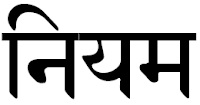Basic differences and similarities of the two
Patanjali’s Yoga Sutras (Raja Yoga) posit the Purusha and Prakriti which basically categorize the sutras as a dualistic philosophy, representing both the manifest (Purusha) and the un-manifest (Prakriti). Whereas the philosophy of Advaita (literally non-dualism), is the premier and oldest of the Vedanta schools of Indian philosophy and was expounded by Adi Shankara (aka, Shankaracharya) historically, the most important teacher of the Advaita school of Vedanta.
Patanjali’s Yoga Sutras
According to Patanjali’s Yoga Sutra’s, the nature of the problem (of Union) is that the individual is identified with his body, senses and mind which are seemingly mixed because of five klesas (aka obstacles, colorings or impurities) among which the primary one is Avidya (ignorance). The sense of ego-I established in a body/mind complex, accompanied by longing and attachment to life, are products of the klesha “Avidya.” In order to remove Avidya, one must know reality (as it is), which according to Patanjali is to separate Purusha (the individual) from Prakriti (the entirety of the cosmos, including mind, senses and elements). In other words, to reach liberation, the aspirant needs to realize (by discrimination and practice) that he is a pure and isolated spiritual entity (purusha) completely distinct from the changing (and as yet un-manifest) processes of nature (prakriti) presenting themselves in his physical body, senses and mind. According to Patanjali, Purusha and Prakriti are both real and independent, although he does say that Prakriti exists for the sake of Purusa.
So, if Purusha and Prakriti are both real and independent of each other, how can they be reconciled through the practice of yoga (union)? Normally Purusha and Prakriti are seen as one and the same, united from time immemorial. But, if through yoga the two are separated, the Purusha will recognize its original, divine glory, and on becoming liberated, reunites with the Atman, Brahman (or Self). So, the practice of yoga, especially the “Eight Limbs of Yoga,” found in chapter II of the Yoga Sutras, is a step-by-step scientific method of separating Purusha and Prakriti attaining this liberation. The Eight Limbs are commonly known as Ashtanga Yoga practice, literally defined – (ashta)-limb, (anga) practice.
Advaita Vedanta
Advaita is a Sanskrit word that means ‘not two.’ Advaitists insist on ‘not two’ rather than ‘only one.’ Osho explains: “The danger in saying ‘one’ is that it gives rise to the idea of two.”
Sri Shankaracharya defines the fundamental tenet of Advaita Vedanta as follows:
“Brahman is the Reality, the universe is an illusion,
The living being is Brahman alone, none else.”
His statement, although it presents the core teaching found in all the Upanishads, has evoked much criticism. Most people are naturally unable to accept the world in which they live and the things they directly perceive and experience throughout their lives as illusion.
But a spiritual aspirant may ask, “Is there a higher state to which I can wake up, so that this illusory, waking world will disappear, just like a dream world?”
The answer is a resounding “yes.” But ironically, what that higher state is no one can describe precisely. This is because non-dualism does not allow for the dichotomy of an experience and one who experiences. The experiencer is lost in the process.
The modern day teachings of Advaita Vedanta, especially as revealed by Sri Ramana Maharshi focused on the practice of Self-inquiry, called Atma-vichara in Sanskrit, which is the most important meditation practice in the Vedantic tradition. It is the main practice of the yoga of knowledge (Jnana Yoga), which itself is traditionally regarded as the highest of the yogas because it can take one most directly to liberation.
Sri Ramana seemed to teach and practice transcendence devoid of any Ashtanga Yoga overtones, except pranayama. When asked about pranayama Sri Ramana said: “This vichara brings about the desired result. For one not so advanced as to engage in it, regulation of breath is prescribed for making the mind quiescent. Quiescence lasts only so long as the breath is controlled.” And when asked; What is the need then for pranayama?
He replied: “Pranayama is meant for one who cannot directly control the thoughts. It serves as a brake to a car. But one should not stop with it but must proceed to pratyahara, dharana and dhyan. After the fruition of dhyana, the mind will come under control even in the absence of pranayama. The asanas (postures) help pranayama, which helps dhyana in its turn, and peace of mind results. Here is the purpose of Hatha Yoga.”
Summary
It is significant that there is really nothing much within the Eight Limbs of Yoga practice which is anti-thetical to Advaita Vedanta; in fact, the Yogic path actually seems to fit quite nicely with Advaitic metaphysics. In samadhi, the eighth and highest limb, the mind loses ego-awareness and becomes one with the object of meditation, but this non-dualistic experience is only “temporary” in Yoga (savikalpa Samadhi), since the ultimate goal of Patanjali’s yoga system is the discrimination of pure consciousness from all those objects it identifies with. But this experience accords very well with the Advaitic aim of “realizing the whole universe as the Self.” (nirvikalpa Samadhi).
Of related interest, click on: The Wisdom of Patanjali
*Rae Indigo is ERYT500
 • Laya and Kundalini Yoga:
• Laya and Kundalini Yoga:

 The second of the five Niyamas is Samtosha (also Santosha) – a Sanskrit term meaning contentment or satisfaction. The word Samtosha is derived from the Sanskrit root word ‘tush’ which means to be satisfied, pleased, or delighted, as well as quiet or calm.
The second of the five Niyamas is Samtosha (also Santosha) – a Sanskrit term meaning contentment or satisfaction. The word Samtosha is derived from the Sanskrit root word ‘tush’ which means to be satisfied, pleased, or delighted, as well as quiet or calm.

